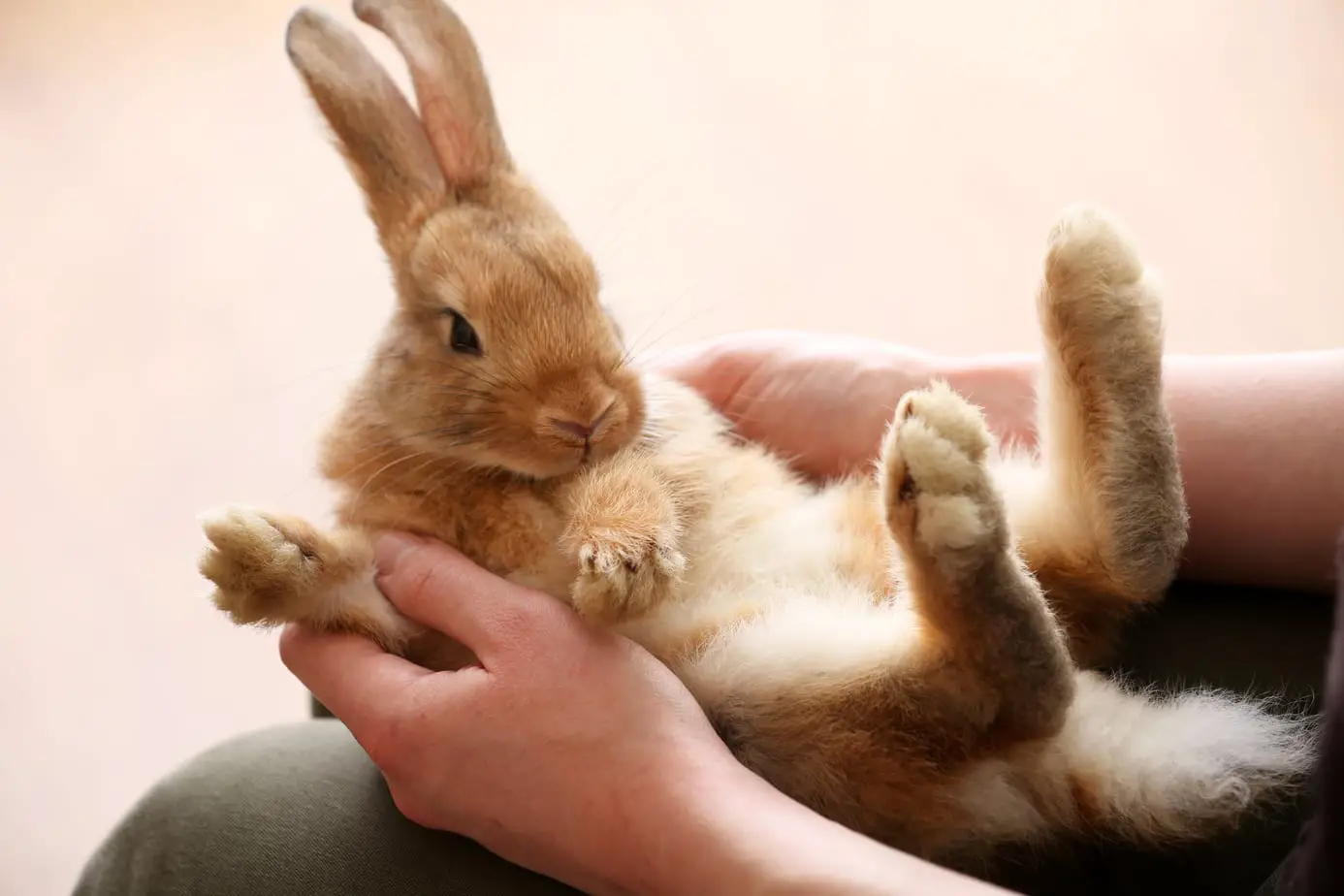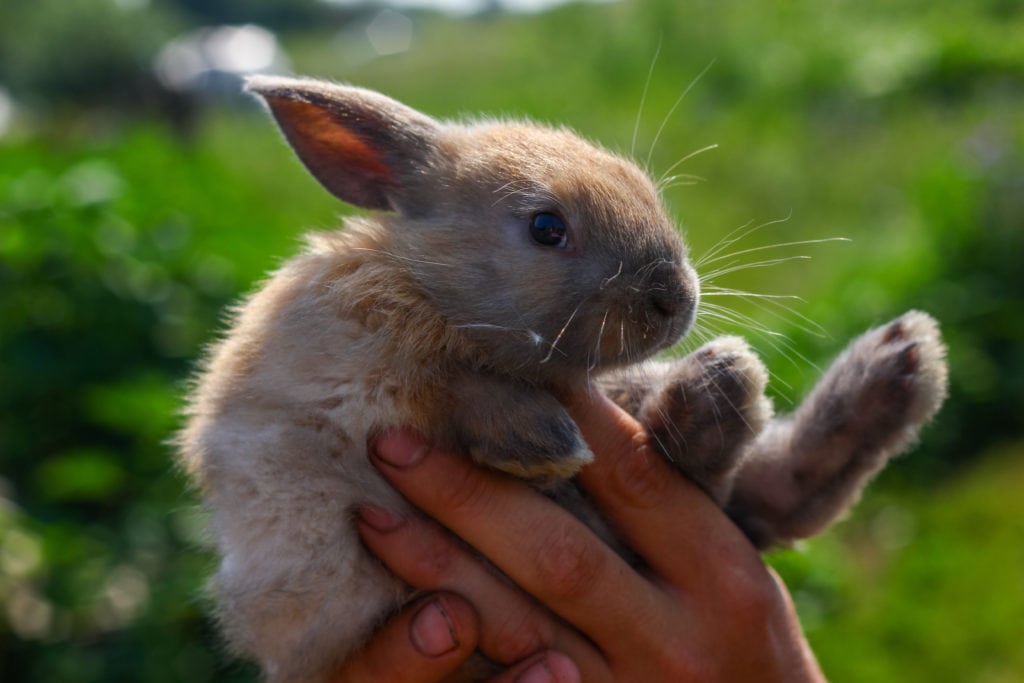
Rabbits are adorable and soft creatures, and humans tend to want to baby them because of their size and cuteness. It sounds charming, but it can be very dangerous for a rabbit, especially when they are being held like a human baby.
Holding your rabbit like a baby is not a safe or responsible practice. Putting rabbits on their backs sends them into a trance state which is actually a defense mechanism and is not safe to put your rabbit into voluntarily. The baby-carry is unsafe, but there are other carrying styles.
Why It’s Dangerous
Carry a rabbit on its back is dangerous for two reasons:
- Their spines are susceptible to breaks – Rabbits’ instincts as prey make them nervous and skittish creatures. That nervousness makes them susceptible to panic attacks, which, in the worst case, can be fatal. Their fear causes them to thrash, and though their muscles are incredibly strong, their skeletons are not, and the thrashing can lead to skeletal damage, most often in their backs.
- They can be sent into a “rabbit trance” which is highly dangerous – This trance-like state is what is known as “tonic immobility.” It is a trait many kinds of animals possess and is also known as “playing dead.” Tonic immobility in rabbits is a defense mechanism that protects them from potential predators.
While rabbits appear to be relaxed when entranced, they are actually in a state of extreme stress. Tonic immobility is something a rabbit would never voluntarily put itself in, and you shouldn’t either.
Other dangers involve your pet rabbits fighting. If your rabbits are fighting a lot, and that is the reason you are trying to hold and comfort your rabbit more often, check out my article Five Reasons Pet Rabbits Fight and How to Stop Them. This article will help you do the best for your rabbits.
Overcoming Dangers
Pet rabbits do need to be held from time to time. You can help your rabbit adjust to being held and pet by being gentle and patient. And of course, each rabbit has different preferences, and it’s up to you to know what your rabbit likes and what it can handle.
The size of the rabbit means they will need to be held differently, but all rabbits need support in their back and legs.

How to Safely Hold Your Rabbit
The key is to support their back and make them feel safe.
- Support the spine
- If the spine is unsupported, or incorrectly supported, the rabbit can severely hurt itself if it panics.
- Keep the spine curved
- Don’t allow them to buck backward if they panic. That is the easiest way for their back to break.
- Support the upper and lower body alike
- The best way to do this is to keep your rabbit’s body gently pressed against yours
- Shield their eyes with the crook of your arm
- They’re less likely to be startled by movement, and the darkness will help soothe them
- Use your body to your advantage
- Especially when removing a rabbit from a carrying cage, always be prepared for them to want to dart out. Keep your body in front of the door so they cannot run away. When replacing them into the cage, use your whole body to guide them inside.
When adjusting your rabbit to being held, sit on the floor and practice. The low center of gravity will keep you both stable.
Additionally, if your rabbit does try to escape, there is less far for them to fall. Or if your rabbit starts to panic, you can quickly and safely set them down. If you have trouble with your rabbit coming back to you, this article Rabbit Only Comes for Food? Six Better Ways to Bond is a great resource for developing a deeper relationship with your rabbit.
Another helpful habit to develop when training your rabbit is to pet them before you pick them up. This will acclimate them to your touch and calm them before you hold them.
What NOT to Do
You must be extremely cautious when handling a rabbit because of its delicacy and nervousness.
Never grab them by:
- The ears
- As one of the most sensitive and delicate parts of a rabbits’ body, damage can be done to the ears if they are inappropriately grabbed and handled
- The stomach
- Think of how you might scoop up a cat, and how its body almost melts around your hands. You might think this method is acceptable for your rabbit, but it actually puts your rabbit’s back in great danger. This is an example of improper back support.
- The tail
- Again, this could scare your rabbit and cause it to buck back in retaliation. You can imagine how this would endanger a rabbit’s spine.
- One of their legs
- This is an exceptionally bad idea. Your rabbit’s leg could be broken or dislocated. Treating the broken leg of a rabbit is much more tedious than exercising care when picking up your rabbit.
- The scruff of their neck
- The scruff is a good area to place your hand in order to stabilize your rabbit when it is wrapped in your arm. Other than that, it is an unwise way to handle your rabbit.
Improper contact with any of these areas is sure to scare your rabbit.
If rabbits and children are playing together, be sure to monitor the children so they do not incorrectly handle and harm the rabbit.

Rabbits do lots of cute things! Bunnies do so many cute things all on their own on a daily basis. To learn about all the cute things they do, see this list of all the reasons bunnies are so cute to own.
Carrying Styles
There is a multitude of different options for holding your rabbit. Each method varies slightly from the other, but all share one similarity: They support and comfort the rabbit.
Keep your rabbit’s body close to yours. Keep them close and keep them stable.
One method is to stabilize the back legs with one hand and stabilize the front legs with the other. With this position, the arm that is pressing your rabbit to your side is in the perfect place to act as a feeding tray or be free to gently pet your pet.
If you find yourself in need of your opposite hand, you can set your rabbit’s feet against your abdomen. Now they can swivel their upper body with their curiosity, or access treats. Another option is to let their feet dangle.
Dangling can seem precarious, but it is actually a sign of relaxation. With smaller rabbits, it is easier to tuck their feet, but for a larger rabbit, dangling is okay, provided the rest of their body is still fully supported.
When you set your rabbit down, place their feet first on a flat surface. If you’d like, you can set them on a towel or rug so their feet have more grip and, therefore, more security.
Keeping the back stabilized will keep them safe, but stabilizing their feet will keep them comfortable.
